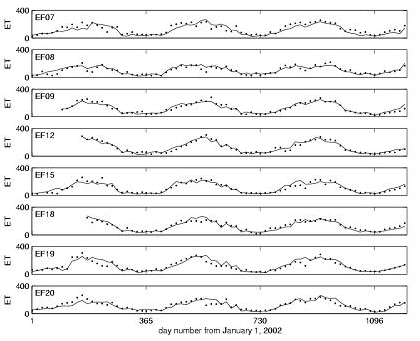Development of a New Method for Estimating Evapotranspiration Using ARM Measurements
Submitter
Li, Zhanqing — University of Maryland
Area of research
Surface Properties
Journal Reference
Wang, K., P. Wang, Z. Li, M. Cribb, and M. Sparrow (2007). A simple method to estimate actual evapotranspiration from a combination of net radiation, vegetation index, and temperature, J. Geophys. Res., 112, D15107, doi:10.1029/2006JD008351.
Wang, K., Z. Li, and M. Cribb (2006). Estimation of evaporative fraction from a combination of day and night land surface temperature and NDVI: A new method to determine the Priestley-Taylor parameter. Remote Sensing of Environment, 102, 293-305.
Science
Satellite remote sensing is a promising technique for estimating global or regional evapotranspiration (ET). A simple and accurate method is essential when estimating ET using remote sensing data. Such a method is investigated by taking advantage of satellite measurements and the extensive ground-based measurements available at eight ARM Climate Research Facility (ACRF) enhanced surface facility locations throughout the Southern Great Plains (SGP) area of the United States from January 2002 to May 2005.
Impact
Data analysis shows that correlation coefficients between ET and surface net radiation are the highest, followed by temperatures (air temperature or land surface temperature) and vegetation indices (enhanced vegetation index [EVI] or normalized difference vegetation index [NDVI]). A simple regression equation is proposed to estimate ET using surface net radiation, air or land surface temperatures, and vegetation indices. ET can be estimated using daytime-averaged air temperature and EVI with a root mean square error (RMSE) of ~30 W m-2, and a correlation coefficient of 0.91 across the sites and the years. ET also can be estimated with comparable accuracy using NDVI. More importantly, the daytime-averaged ET also can be estimated using only one measurement per day of temperatures (the daytime maximum air temperature) with comparable accuracy. Sensitivity analysis shows that the proposed method is only slightly sensitive to the error of temperatures, vegetation indices, and net radiation. Independent validation is made using the measurements by the eddy-covariance method at six AmeriFlux sites throughout the United States from 2001 to 2006. The land cover of the AmeriFlux sites varies from grassland to cropland and forest.
Summary
The results show that ET can be predicted with a correlation coefficient varying from 0.84 to 0.95. Also, the bias varies from 3 W m-2 to 15 W m-2 and the RMSE varies from ~30 W m-2 to ~40 W m-2. The positive bias partly comes from the imbalance problem of the eddy covariance method. The method proposed can predict ET under a wide range of soil moisture content and land cover.


